Abstract
The autologous mixed-lymphocyte reactions (AMLR) of peripheral blood lymphocytes from 80 patients with adult periodontitis were examined. Some but not all patients showed clearly low AMLR responses; 31 of 80 subjects (39%) showing consistently low responses in AMLR (less than the mean--2 standard deviations of the healthy control group values) were designated low-AMLR patients, whereas the 42 patients (53%) who showed normal AMLR responses were designated normal-AMLR patients. However, there were no significant differences in the clinical parameters between these two groups of patients. The phenotypic analysis of T-cell fractions revealed a lower percentage of CD45RA-positive cells in CD4-positive cells (CD4+ CD45RA+ T cells) in the low-AMLR patients than those in normal-AMLR patients and healthy control subjects. No significant differences were demonstrated between the two groups in terms of the proportion of CD4-positive and CD8-positive cells in the T-cell fractions or in the expression of human leukocyte antigen DR of the monocytes and B cells in the non-T-cell fractions. In the low-AMLR patients, the allogeneic MLR was found to be normal, but the interleukin 2 production in the AMLR was found to be significantly depressed. The depressed AMLR responses and the lower percentage of CD4+ CD45RA+ T cells in the low-AMLR patients were found to be normalized following the periodontal therapy. These results might reflect changes in regulatory T-cell function induced by development of periodontal diseases.
Full text
PDF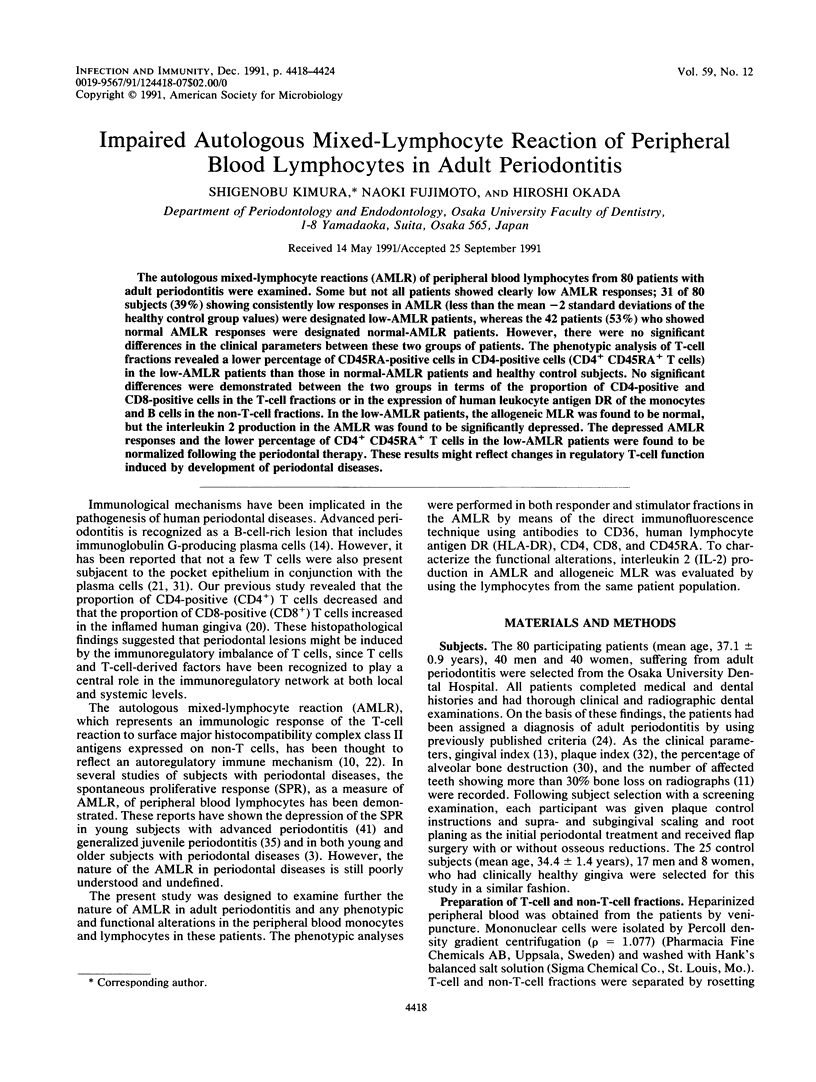
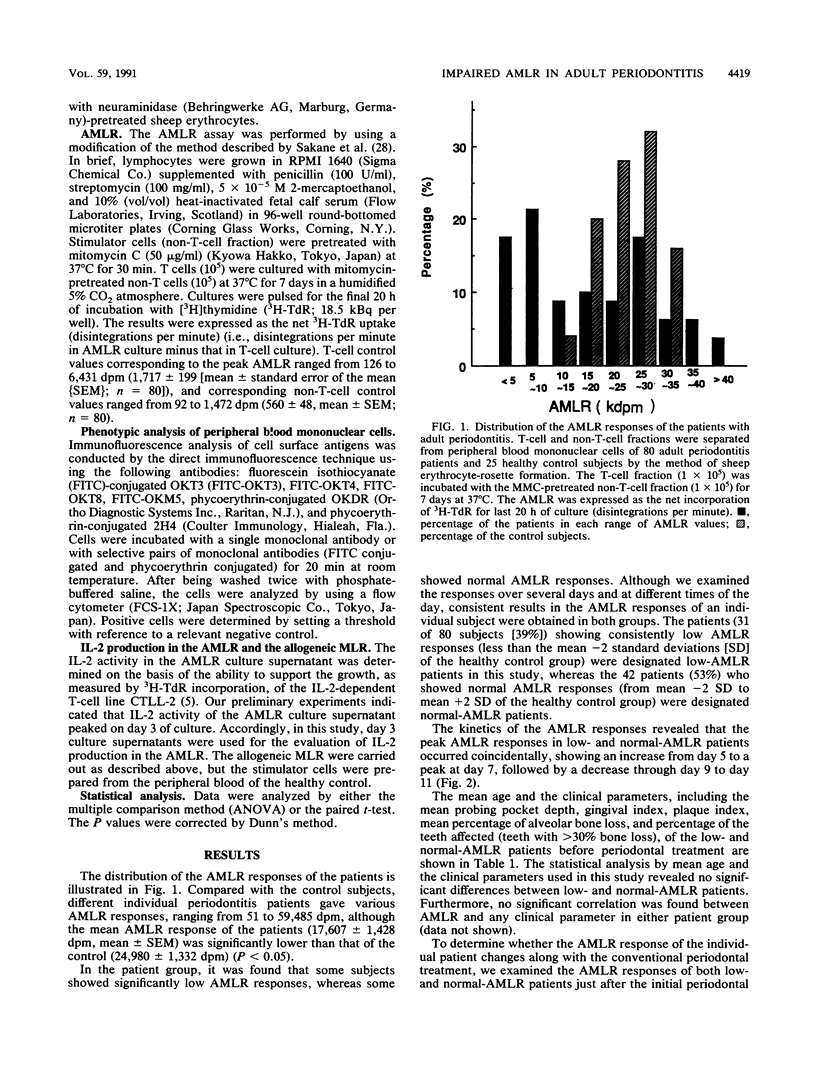
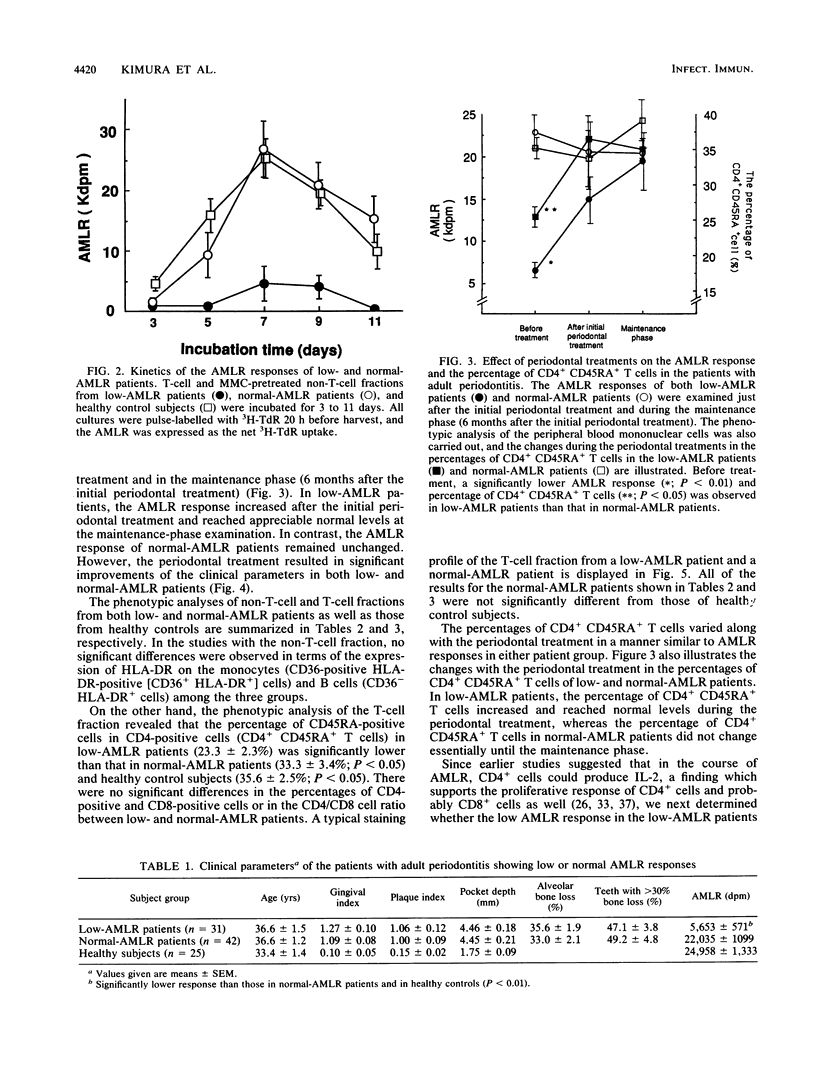

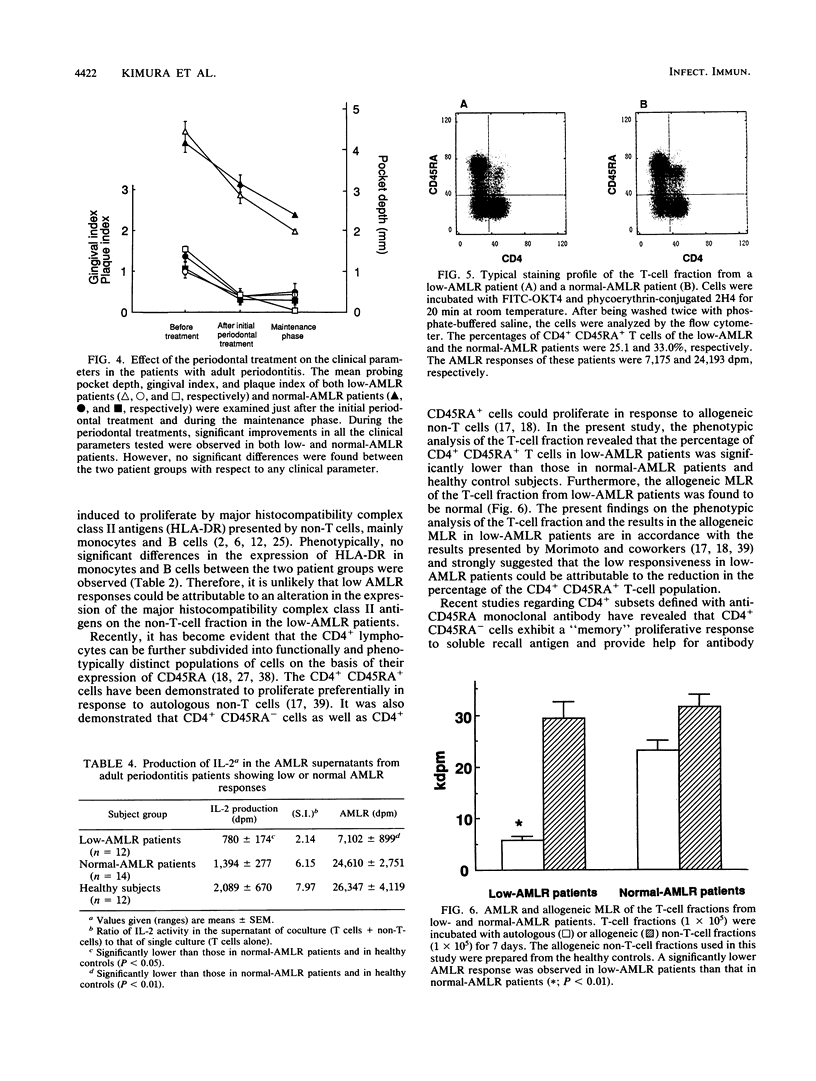
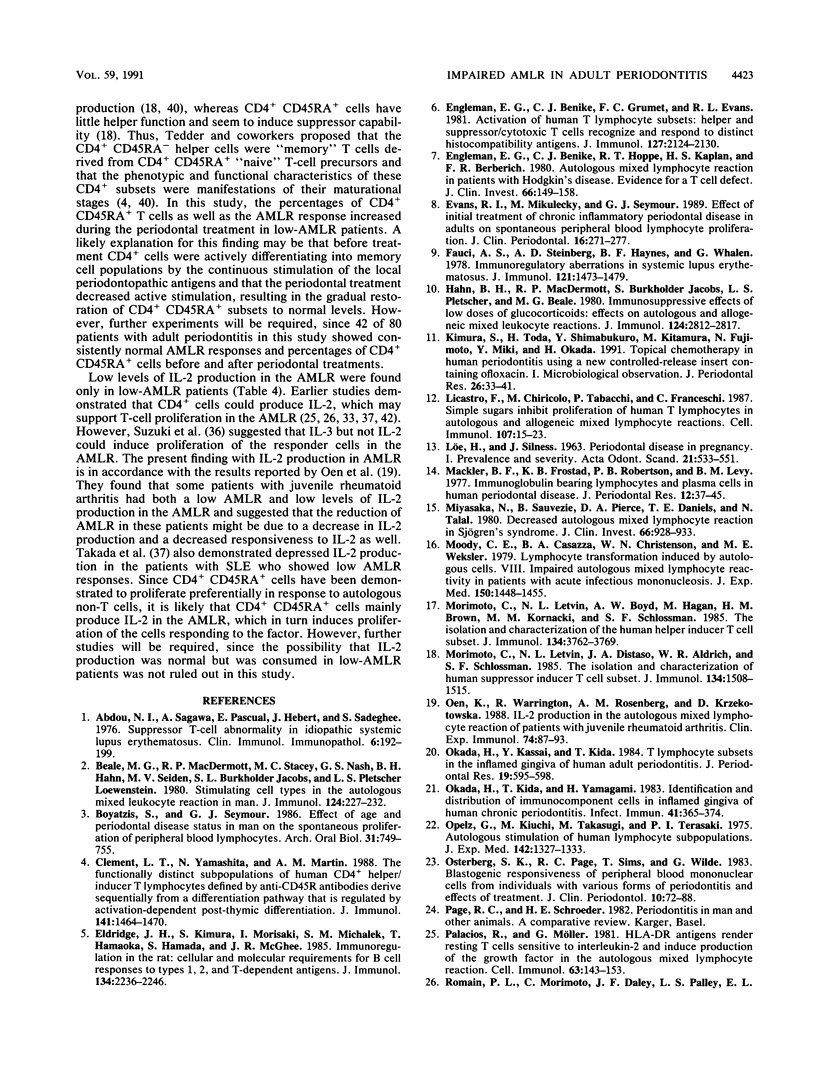

Selected References
These references are in PubMed. This may not be the complete list of references from this article.
- Abdou N. I., Sagawa A., Pascual E., Hebert J., Sadeghee S. Suppressor T-cell abnormality in idiopathic systemic lupus erythematosus. Clin Immunol Immunopathol. 1976 Sep;6(2):192–199. doi: 10.1016/0090-1229(76)90110-0. [DOI] [PubMed] [Google Scholar]
- Beale M. G., MacDermott R. P., Stacey M. C., Nash G. S., Hahn B. H., Seiden M. V., Jacobs S. L., Loewenstein L. S. Stimulating cell types in the autologous mixed leukocyte reaction in man. J Immunol. 1980 Jan;124(1):227–232. [PubMed] [Google Scholar]
- Boyatzis S., Seymour G. J. Effect of age and periodontal disease status in man on the spontaneous proliferation of peripheral blood lymphocytes. Arch Oral Biol. 1986;31(11):749–755. doi: 10.1016/0003-9969(86)90007-5. [DOI] [PubMed] [Google Scholar]
- Clement L. T., Yamashita N., Martin A. M. The functionally distinct subpopulations of human CD4+ helper/inducer T lymphocytes defined by anti-CD45R antibodies derive sequentially from a differentiation pathway that is regulated by activation-dependent post-thymic differentiation. J Immunol. 1988 Sep 1;141(5):1464–1470. [PubMed] [Google Scholar]
- Eldridge J. H., Kimura S., Morisaki I., Michalek S. M., Hamaoka T., Hamada S., McGhee J. R. Immunoregulation in the rat: cellular and molecular requirements for B cell responses to types 1, 2, and T-dependent antigens. J Immunol. 1985 Apr;134(4):2236–2246. [PubMed] [Google Scholar]
- Engleman E. G., Benike C. J., Grumet F. C., Evans R. L. Activation of human T lymphocyte subsets: helper and suppressor/cytotoxic T cells recognize and respond to distinct histocompatibility antigens. J Immunol. 1981 Nov;127(5):2124–2129. [PubMed] [Google Scholar]
- Engleman E. G., Benike C. J., Hoppe R. T., Kaplan H. S., Berberich F. R. Autologous mixed lymphocyte reaction in patients with Hodgkin's disease. Evidence for a T cell defect. J Clin Invest. 1980 Jul;66(1):149–158. doi: 10.1172/JCI109828. [DOI] [PMC free article] [PubMed] [Google Scholar]
- Evans R. I., Mikulecky M., Seymour G. J. Effect of initial treatment of chronic inflammatory periodontal disease in adults on spontaneous peripheral blood lymphocyte proliferation. J Clin Periodontol. 1989 May;16(5):271–277. doi: 10.1111/j.1600-051x.1989.tb01654.x. [DOI] [PubMed] [Google Scholar]
- Fauci A. S., Steinberg A. D., Haynes B. F., Whalen G. Immunoregulatory aberrations in systemic lupus erythematosus. J Immunol. 1978 Oct;121(4):1473–1479. [PubMed] [Google Scholar]
- Hahn B. H., MacDermott R. P., Jacobs S. B., Pletscher L. S., Beale M. G. Immunosuppressive effects of low doses of glucocorticoids: effects on autologous and allogeneic mixed leukocyte reactions. J Immunol. 1980 Jun;124(6):2812–2817. [PubMed] [Google Scholar]
- Kimura S., Toda H., Shimabukuro Y., Kitamura M., Fujimoto N., Miki Y., Okada H. Topical chemotherapy in human periodontitis using a new controlled-release insert containing ofloxacin. I. Microbiological observation. J Periodontal Res. 1991 Jan;26(1):33–41. doi: 10.1111/j.1600-0765.1991.tb01623.x. [DOI] [PubMed] [Google Scholar]
- LOE H., SILNESS J. PERIODONTAL DISEASE IN PREGNANCY. I. PREVALENCE AND SEVERITY. Acta Odontol Scand. 1963 Dec;21:533–551. doi: 10.3109/00016356309011240. [DOI] [PubMed] [Google Scholar]
- Licastro F., Chiricolo M., Tabacchi P., Franceschi C. Simple sugars inhibit proliferation of human T lymphocytes in autologous and allogeneic mixed lymphocyte reactions. Cell Immunol. 1987 Jun;107(1):15–23. doi: 10.1016/0008-8749(87)90261-9. [DOI] [PubMed] [Google Scholar]
- Mackler B. F., Frostad K. B., Robertson P. B., Levy B. M. Immunoglobulin bearing lymphocytes and plasma cells in human periodontal disease. J Periodontal Res. 1977 Jan;12(1):37–45. doi: 10.1111/j.1600-0765.1977.tb00107.x. [DOI] [PubMed] [Google Scholar]
- Miyasaka N., Sauvezie B., Pierce D. A., Daniels T. E., Talal N. Decreased autologous mixed lymphocyte reaction in Sjögren's syndrome. J Clin Invest. 1980 Nov;66(5):928–933. doi: 10.1172/JCI109960. [DOI] [PMC free article] [PubMed] [Google Scholar]
- Moody C. E., Casazza B. A., Christenson W. N., Weksler M. E. Lymphocyte transformation induced by autologous cells. VIII. Impaired autologous mixed lymphocyte reactivity in patients with acute infectious mononucleosis. J Exp Med. 1979 Dec 1;150(6):1448–1455. doi: 10.1084/jem.150.6.1448. [DOI] [PMC free article] [PubMed] [Google Scholar]
- Morimoto C., Letvin N. L., Boyd A. W., Hagan M., Brown H. M., Kornacki M. M., Schlossman S. F. The isolation and characterization of the human helper inducer T cell subset. J Immunol. 1985 Jun;134(6):3762–3769. [PubMed] [Google Scholar]
- Morimoto C., Letvin N. L., Distaso J. A., Aldrich W. R., Schlossman S. F. The isolation and characterization of the human suppressor inducer T cell subset. J Immunol. 1985 Mar;134(3):1508–1515. [PubMed] [Google Scholar]
- Oen K., Warrington R., Rosenberg A. M., Krzekotowska D. IL-2 production in the autologous mixed lymphocyte reaction of patients with juvenile rheumatoid arthritis. Clin Exp Immunol. 1988 Oct;74(1):87–93. [PMC free article] [PubMed] [Google Scholar]
- Okada H., Kassai Y., Kida T. T lymphocyte subsets in the inflamed gingiva of human adult periodontitis. J Periodontal Res. 1984 Nov;19(6):595–598. doi: 10.1111/j.1600-0765.1984.tb01322.x. [DOI] [PubMed] [Google Scholar]
- Okada H., Kida T., Yamagami H. Identification and distribution of immunocompetent cells in inflamed gingiva of human chronic periodontitis. Infect Immun. 1983 Jul;41(1):365–374. doi: 10.1128/iai.41.1.365-374.1983. [DOI] [PMC free article] [PubMed] [Google Scholar]
- Opelz G., Kiuchi M., Takasugi M., Terasaki P. I. Autologous stimulation of human lymphocyte subpopulation. J Exp Med. 1975 Nov 1;142(5):1327–1333. doi: 10.1084/jem.142.5.1327. [DOI] [PMC free article] [PubMed] [Google Scholar]
- Osterberg S. K., Page R. C., Sims T., Wilde G. Blastogenic responsiveness of peripheral blood mononuclear cells from individuals with various forms of periodontitis and effects of treatment. J Clin Periodontol. 1983 Jan;10(1):72–88. doi: 10.1111/j.1600-051x.1983.tb01269.x. [DOI] [PubMed] [Google Scholar]
- Palacios R., Möller G. HLA-DR antigens render resting T cells sensitive to interleukin-2 and induce production of the growth factor in the autologous mixed lymphocyte reaction. Cell Immunol. 1981 Sep 1;63(1):143–153. doi: 10.1016/0008-8749(81)90035-6. [DOI] [PubMed] [Google Scholar]
- Romain P. L., Morimoto C., Daley J. F., Palley L. S., Reinherz E. L., Schlossman S. F. Reactivity of inducer cell subsets and T8-cell activation during the human autologous mixed lymphocyte reaction. Clin Immunol Immunopathol. 1984 Jan;30(1):117–128. doi: 10.1016/0090-1229(84)90012-6. [DOI] [PubMed] [Google Scholar]
- Rudd C. E., Morimoto C., Wong L. L., Schlossman S. F. The subdivision of the T4 (CD4) subset on the basis of the differential expression of L-C/T200 antigens. J Exp Med. 1987 Dec 1;166(6):1758–1773. doi: 10.1084/jem.166.6.1758. [DOI] [PMC free article] [PubMed] [Google Scholar]
- SILNESS J., LOE H. PERIODONTAL DISEASE IN PREGNANCY. II. CORRELATION BETWEEN ORAL HYGIENE AND PERIODONTAL CONDTION. Acta Odontol Scand. 1964 Feb;22:121–135. doi: 10.3109/00016356408993968. [DOI] [PubMed] [Google Scholar]
- Sakane T., Steinberg A. D., Green I. Failure of autologous mixed lymphocyte reactions between T and non-T cells in patients with systemic lupus erythematosus. Proc Natl Acad Sci U S A. 1978 Jul;75(7):3464–3468. doi: 10.1073/pnas.75.7.3464. [DOI] [PMC free article] [PubMed] [Google Scholar]
- Sauvezie B., Miyasaka N., Charron D., Kielich C., Loeb J., Daniels T. E., Talal N. An increase in peripheral blood Ia-positive T cells in Sjögren's syndrome correlates with a decrease in the autologous mixed lymphocyte response. Clin Exp Immunol. 1982 Jul;49(1):50–58. [PMC free article] [PubMed] [Google Scholar]
- Seymour G. J., Greenspan J. S. The phenotypic characterization of lymphocyte subpopulations in established human periodontal disease. J Periodontal Res. 1979 Jan;14(1):39–46. doi: 10.1111/j.1600-0765.1979.tb00216.x. [DOI] [PubMed] [Google Scholar]
- Smolen J. S., Luger T. A., Chused T. M., Steinberg A. D. Responder cells in the human autologous mixed lymphocyte reaction. J Clin Invest. 1981 Dec;68(6):1601–1604. doi: 10.1172/JCI110416. [DOI] [PMC free article] [PubMed] [Google Scholar]
- Stephens H. A., Fitzharris P., Knight R. A., Snaith M. L. Inhibition of proliferative and suppressor responses in the autologous mixed lymphocyte reaction by serum from patients with systemic lupus erythematosus. Ann Rheum Dis. 1982 Oct;41(5):495–501. doi: 10.1136/ard.41.5.495. [DOI] [PMC free article] [PubMed] [Google Scholar]
- Suzuki J. B., Park S. K., Falkler W. A., Jr Immunologic profile of juvenile periodontitis. I. Lymphocyte blastogenesis and the autologous mixed lymphocyte response. J Periodontol. 1984 Aug;55(8):453–460. doi: 10.1902/jop.1984.55.8.453. [DOI] [PubMed] [Google Scholar]
- Suzuki R., Suzuki S., Takahashi T., Kumagai K. Production of a cytokine with interleukin 3-like properties and cytokine-dependent proliferation in human autologous mixed lymphocyte reaction. J Exp Med. 1986 Nov 1;164(5):1682–1699. doi: 10.1084/jem.164.5.1682. [DOI] [PMC free article] [PubMed] [Google Scholar]
- Takada S., Ueda Y., Suzuki N., Murakawa Y., Hoshino T., Green I., Steinberg A. D., Horwitz D. A., Sakane T. Abnormalities in autologous mixed lymphocyte reaction-activated immunologic processes in systemic lupus erythematosus and their possible correction by interleukin 2. Eur J Immunol. 1985 Mar;15(3):262–267. doi: 10.1002/eji.1830150310. [DOI] [PubMed] [Google Scholar]
- Takeuchi T., Rudd C. E., Schlossman S. F., Morimoto C. Induction of suppression following autologous mixed lymphocyte reaction; role of a novel 2H4 antigen. Eur J Immunol. 1987 Jan;17(1):97–103. doi: 10.1002/eji.1830170117. [DOI] [PubMed] [Google Scholar]
- Takeuchi T., Schlossman S. F., Morimoto C. The T4 molecule differentially regulating the activation of subpopulations of T4+ cells. J Immunol. 1987 Aug 1;139(3):665–671. [PubMed] [Google Scholar]
- Tedder T. F., Cooper M. D., Clement L. T. Human lymphocyte differentiation antigens HB-10 and HB-11. II. Differential production of B cell growth and differentiation factors by distinct helper T cell subpopulations. J Immunol. 1985 May;134(5):2989–2994. [PubMed] [Google Scholar]
- Tew J. G., Burmeister J. A., Palcanis K. G., Ranney R. R. Spontaneous lymphocyte proliferation and the periodontal status of young adults. J Periodontal Res. 1983 Sep;18(5):534–540. doi: 10.1111/j.1600-0765.1983.tb00390.x. [DOI] [PubMed] [Google Scholar]
- Yoshioka K., Kakumu S., Murakami H., Fukui K. Interleukin-2 activity in chronic active liver diseases: response by T cells and in the autologous mixed lymphocyte reaction. Clin Exp Immunol. 1984 Jun;56(3):669–676. [PMC free article] [PubMed] [Google Scholar]


